The Heiligenschein
On a morning when shadows are long and the grass is wet with dew, you may see a sparkling white glow around the shadow of your head. This is known as the 'heiligenschein', which is German for the 'light of the holy one'.
The glow is centered on the antisolar point and so each person has their own. For pictures of the heiligenschein, check out the site www.meteoros.de/heilig/heilig_b.htm. Notice that when the camera is moved out to arm's length, the heiligenschein moves with it.
Heiligenschein Mechanism
For a background on how the heiligenschein works, see my discussion of some properties of animal eyes that are closely connected to the heiligenschein. Another place where this phenomenon can be viewed is on highway signs or license plates where the surface is covered with small glass beads, each of which acts as a small eyeball, selectively sending light back toward the direction of the car headlights that illuminate it.
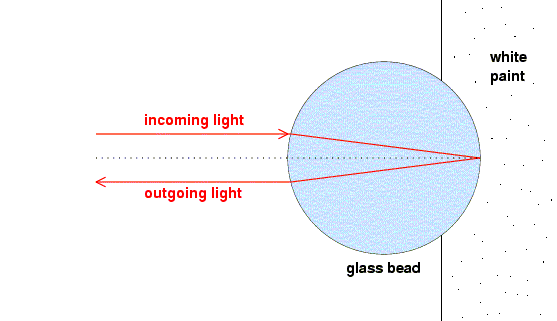
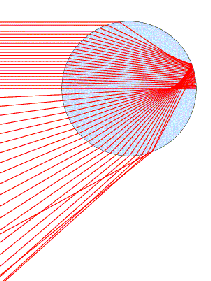 In the heiligenschein, the nearly spherical dew drops take over the role of the eyeball.
However, water has a lower index of refraction (approximately 4/3) than glass. Therefore,
water does not bend light as much as glass, so external and internal reflections by the
dewdrop can not solely be the cause of the heiligenschein. The drawing to the right indicates
that light entering the droplet is only reflected back in the same direction that it came
when it enters at the equator of the water droplet. Therefore, back reflection can not
explain the heiligenschein. For a detailed mathematical explanation of this, click
here.
In the heiligenschein, the nearly spherical dew drops take over the role of the eyeball.
However, water has a lower index of refraction (approximately 4/3) than glass. Therefore,
water does not bend light as much as glass, so external and internal reflections by the
dewdrop can not solely be the cause of the heiligenschein. The drawing to the right indicates
that light entering the droplet is only reflected back in the same direction that it came
when it enters at the equator of the water droplet. Therefore, back reflection can not
explain the heiligenschein. For a detailed mathematical explanation of this, click
here.
A useful scientific model was proposed in 1874 by Lommel and is still the leading explanation for the heiligenschein today. Lommel noticed that the water droplet rests on small hairs which separate it from the leaf's surface. The drop brings sunlight to a crude focus. When this is at the leaf surface, some light is scattered back through the drop to form the heiligenschein.
The drawing below shows light focused on a leaf by a drop of water. Clearly the water drop and leaf hairs are not drawn to size.
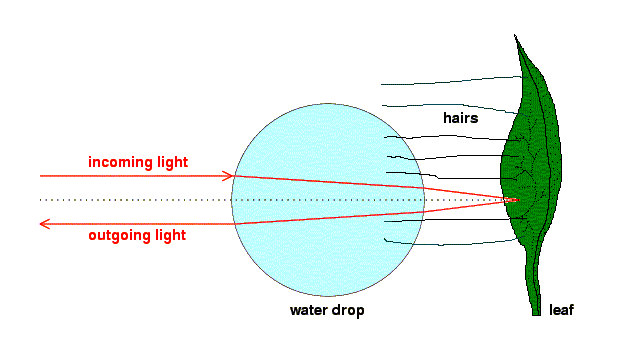
Lommel's model relied heavily on hairy leaves to hold the dewdrop 1 focal length from the surface. If we treat the drop as a thin lens, we can show that light is focused 1 radius length past the drop. For this explanation, consider the picture of half a dewdrop below.
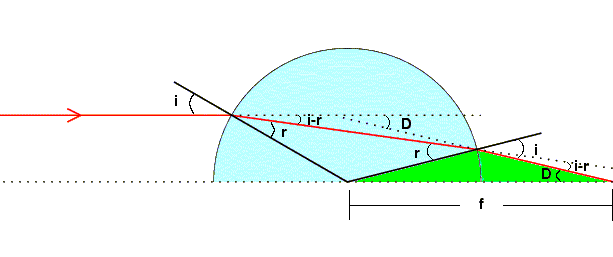
In this model, the light ray from the Sun, the axis of the lens (the dewdrop), and the normal to the plane (the leaf) are coaxial. Additionally, the index of refraction, n=4/3. A light ray that enters the drop at an incident angle of i is deviated, after two refractions, through an angle D=2(i-r), where r is the angle of refraction specified by Snell's Law, sin i = n sin r. The focal length f is the distance from the drop center to the point where the ray intersects the axis which is parallel to the initial ray. Applying the law of sines to the green shaded triangle produces the result f=sini/sinD .
If only paraxial rays (rays which are always very close to, and very neatly parallel
to the optical axis) are considered, all of the angles are small, and
This makes the f-number (which is equal to the focal length / diameter) fn=1 for a water drop. Therefore, the light is indeed focused 1 radius length past the drop
Now consider what happens when light reaches the leaf surface. Light from the bright leaf spot (the point where it is focused) scatters in all directions but some returns through the droplet along almost the same paths it came. The net effect is that each drop 'backscatters' sunlight, returning it most brightly in directions toward the sun.
Lets consider the difference between when a leaf is directly illuminated by a source and when a lens (the water droplet) is placed in between the leaf and the light source.
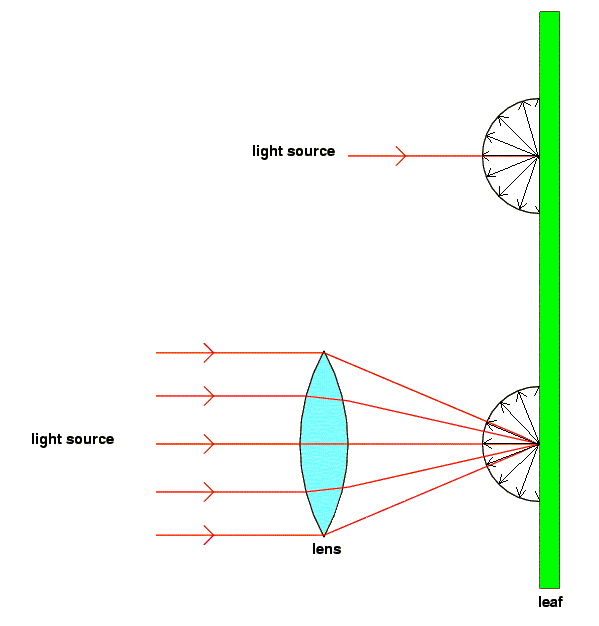
Without the lens, only a small fraction of the light that is diffusely reflected off the leaf is channeled back toward the source. Thus when there is a lens, a larger fraction of the diffusely scattered light is sent back in the original direction. Dew thus acts as a thin lens and shines brightly at the antisolar point to form a heiligenschein.
The heiligenschein looks white rather than green because the individual points of light saturate the eye's colour receptors and to some extent cameras.
Sources
Fraser, A.B. 1994. The Sylvanshine - Retroreflection from dew-covered trees. Applied Optics 33 (21):4539-4547.
Greenler, R. 1980. Rainbows, Halos, and Glories. Cambridge University Press: Cambridge.
Hinz, C. Heiligenschein. http://www.meteoros.de/heilig/heilig_b.htm.
Minnaert, M. 1954. The Nature of Light and Colour in the Open Air. Dover Publications Inc.: New York.
Tricker, R.A.R. 1970. Introduction to Meteorological Optics. Mills & Boon Ltd.: London.